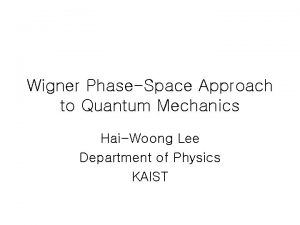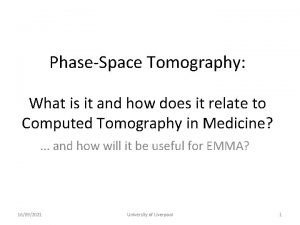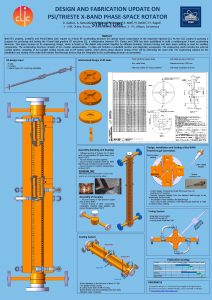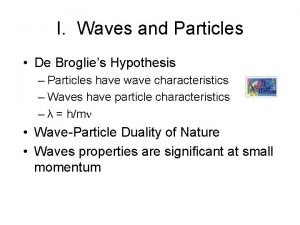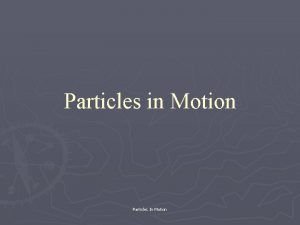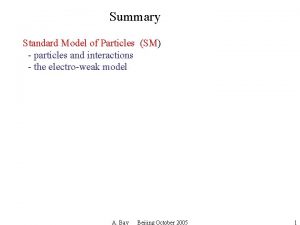The PhaseSpace Approach to LFV LFV Particles and















- Slides: 15

The Phase-Space Approach to LFV: LFV Particles and Waves, Model Hierarchies and Data Sets Michael Ghil Ecole Normale Supérieure, Paris, and University of California, Los Angeles Joint work with many people, most recently: R. Berk, U. Penn. ; F. D’Andrea, LMD/ENS, Paris; A. Deloncle, Ecole Polytechnique, Paris; B. Deremble, ENS, Paris; D. Kondrashov, UCLA Pls. see this site for further details: http: //www. atmos. ucla. edu/tcd/,

Motivation • The atmosphere is an open system subject to multiple instabilities that interact nonlinearly and are limited in energy. • Bounded energy and prevalence of dissipation suggest the existence of lower-dimensional attractors; instabilities and observations suggest that these are strange or worse. • Boundedness in phase space and observations also suggest recurrence of large-scale features on time scales of interest. • Two types of recurrent, but unstable features — fixed points (“particles”) and limit cycles (“waves”) — seem to dominate low-frequency variability (LFV). • They lie at the basis of two approaches to long-range forecasting (LRF): Markov chains and spectral methods. • Simple, “toy” models can provide useful ideas, while the hierarchical modeling approach allows one to go back-and-forth between toy (“conceptual”) and detailed (“realistic”) models, and between models and data.

LFV* Observations: Multiple space and time scales w A high-variability ridge lies close to the diagonal of the plot (cf. also Fraedrich & Böttger, 1978, JAS) * LFV 10– 100 days (intraseasonal)

Blocking: a paradigm of persistent anomaly Bauer, Namias, Rex and many others noticed the recurrence and persistence of blocking. J. Charney decided to go beyond “talking about it, ” and actually “do something about it. ” Monthly mean 500 -h. Pa map for January 1963 (from Ghil & Childress, 1987)

Transitions Between Blocked and Zonal Flows in a Rotating Annulus with Topography Zonal Flow 13– 22 Dec. 1978 Blocked Flow 10– 19 Jan. 1963 E. R. Weeks, Y. Tian, J. S. Urbach, K. Ide, H. L. Swinney, & M. Ghil, 1997: Science, 278, 1598– 1601.

A toy model for blocking vs. zonal flow Quasi-geostrophic flow in a mid-latitude -channel, with 3 -mode truncation (zonal + 1 wave). Topographic resonance leads to multiple equilibria: zonal + blocked. Much criticized as “unrealistic. ” Charney & De. Vore, 1979: J. Atmos. Sci. , 36, 1205– 1216.

From Regimes to Markov Chains w Each regime R has an expected duration R. w Expected transition probability from regime A to B is p. AB. w Transitions do NOT occur via the mean state, which is a statistical “accident” or, maybe, the root of the “bifurcation tree. ” From Ghil (1987), in Nicolis & Nicolis (eds. ).

How to get from a regime to another? – I w Stochastic perturbations w Heteroclinic and homoclinic orbits w Chaotic itinerancy w All of the above Ghil & Childress, 1987: Ch. 6

Multiple Flow Regimes A. Classification schemes 1) By position (i) Cluster analysis– categorical – NH, Mo & Ghil (1988, JGR) – fuzzy – NH + sectorial, Michelangeli et al. (1995, JAS) – hard (K–means) – hierarchical – NH + sectorial, Cheng & Wallace (1993, JAS) (ii) PDF estimation – univariate: – NH, Benzi et al. (1986, QJRMS); Hansen & Sutera (1995, JAS) – multivariate: – NH, Molteni et al. (1990, QJRMS); Kimoto & Ghil (1993 a, JAS – sectorial, Kimoto & Ghil (1993 b, JAS); Smyth et al. (1999, JAS) 2) By persistence (iii) Pattern correlations – NH, Horel (1985, MWR); SH, Mo & Ghil (1987, JAS) (iv) Minima of tendencies – Models: Legras & Ghil (1985, JAS); Mukougawa (1988, JAS); Vautard & Legras (1988, JAS) – Atl. - Eur. sector : Vautard (1990, MWR) B. Transition probabilities (v) Model & NH – counts (Mo & Ghil, 1988, JGR) (vi) NH & SH – Monte Carlo (Vautard et al. , 1990, JAS)

How to get from a regime to another? – II w Even something as simple as a periodically forced damped pendulum can have complex behavior. w Here are 4 attractor basins, each with a different type of behavior. w Time to get there is shown by brightness of color. http: //www-chaos. umd. edu/gallery/basinpics. html

Preferred Transition Paths w Conjectured by Legras & Ghil (JAS, 1985) in toy model (25 Ynm). w Captured by Kondrashov et al. (JAS, 2004) in intermediate QG 3 (Marshall & Molteni, 1993) model. w Exit angles used as predictors in statistical, random-forests algorithm: - for QG 3 model by Deloncle et al. (JAS, 2006); - for NH reanalysis data by Kondrashov et al. (Clim. Dyn. , 2007).

NWP Model Performance on Blocking Leading numerical weather prediction (NWP) models still underestimate badly blocking occurrence and persistence: ECMWF Era 40 model Met Office ECMWF - European Centre Met Office - United Kingdom CNRM - Météo-France CNRM T. N. Palmer et al. , 2007: Bull. Amer. Met. Soc. , sub judice (pers. commun. )

A few questions left: Are the regimes but slow phases of the oscillations? Are the oscillations but instabilities of particular fixed points? How about both? – chaotic itinerancy How about neither? – just interference of linear waves; – just red noise.

Concluding remarks w Dynamical systems theory provides major insights into nonlinear planetary flows: w bifurcation theory helps understand how spatio-temporal patterns arise in observed flows and detailed numerical simulations (GCMs); w ergodic theory helps connects the statistics of the flows (EOFs, PDFs, Markov chains) to their dynamics. • These theories are most easily understood for highly simplified models but they do apply to the full PDE systems that govern the actual flows. • The simplification often consists in a reduced number of modes (d-o-f’s), as well as simplified physical processes. • Increase gradually model resolution and sophistication: move up & down model hierarchy, continuously comparing models with the data.

Some general references Lorenz, E. N. , 1963 b: The mechanics of vacillation. J. Atmos. Sci. , 20, 448– 464. Charney, J. G. , and J. De. Vore, 1979: Multiple flow equilibria in the atmosphere and blocking. J. Atmos. Sci. , 36, 1205– 1216. Charney, J. G. , J. Shukla, and K. C. Mo, 1981: Comparison of a barotropic blocking theory with observation. J. Atmos. Sci. , 38, 762– 779. Charney, J. G. and D. M. Straus, 1981: Form-drag instability, multiple equilibria and propagating planetary waves in baroclinic, orographically forced planetary wave systems. J. Atmos. Sci. , 38, 1157– 1176. Ghil, M. , R. Benzi, and G. Parisi (Eds. ), 1985: Turbulence and Predictability in Geophysical Fluid Dynamics and Climate Dynamics, North-Holland, 449 pp. Ghil, M. , and S. Childress, 1987: Topics in Geophysical Fluid Dynamics: Atmospheric Dynamics, Dynamo Theory and Climate Dynamics, Springer-Verlag, 485 pp. Corti, S. , F. Molteni, and T. N. Palmer, 1999 "Signature of recent climate change in frequencies of natural atmospheric circulation regimes". Nature, 398, 799– 802. Ghil, M. , and A. W. Robertson, 2002: "Waves" vs. "particles" in the atmosphere's phase space: A pathway to long-range forecasting? Proc. Natl. Acad. Sci. USA, 99 (Suppl. 1), 2493– 2500. Kalnay, E. , 2003. Atmospheric Modeling, Data Assimilation and Predictability. Cambridge Univ. Press, Cambridge/London, 341 pp. Ghil, M. , and E. Simonnet, 2007: Nonlinear Climate Theory, Cambridge Univ. Press, Cambridge, UK/London/New York, in preparation (approx. 450 pp. ).
 A switch in a datagram network uses a
A switch in a datagram network uses a Tony wagner's seven survival skills
Tony wagner's seven survival skills Cognitive approach vs behavioral approach
Cognitive approach vs behavioral approach Waterfall approach vs shower approach
Waterfall approach vs shower approach Multiple approach avoidance conflict
Multiple approach avoidance conflict Cognitive approach vs behavioral approach
Cognitive approach vs behavioral approach Study approach meaning
Study approach meaning Traditional approach of development
Traditional approach of development Hát kết hợp bộ gõ cơ thể
Hát kết hợp bộ gõ cơ thể Ng-html
Ng-html Bổ thể
Bổ thể Tỉ lệ cơ thể trẻ em
Tỉ lệ cơ thể trẻ em Chó sói
Chó sói Thang điểm glasgow
Thang điểm glasgow Alleluia hat len nguoi oi
Alleluia hat len nguoi oi Môn thể thao bắt đầu bằng chữ f
Môn thể thao bắt đầu bằng chữ f

















